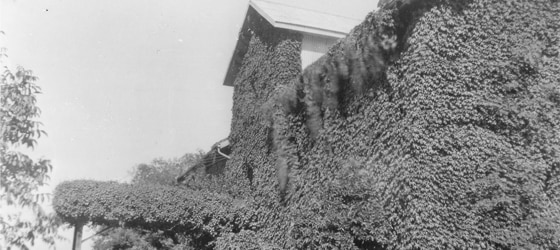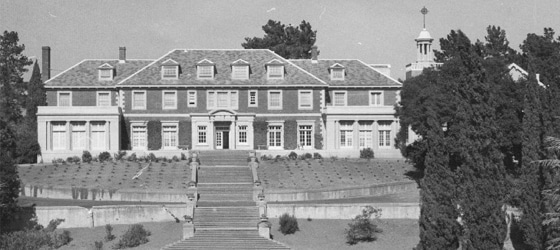Tidings, Wine and Viticulture
The Good Life in Oakville: A History of the Far Niente Winery
This is an excerpt of an article written by Tom Spaulding, a local photographer and historian. It was first published in the Vol. 22, No. 2 edition of Tidings, our quarterly newsletter. To get your copy of Tidings, become a member today!
Discover what we have on Far Niente in our Research Library, and learn more about Oakville.

Far Niente is the name of the premium winery that occupies the 1885-86 stone building there; the name predates the building and was the name of California pioneer John Benson’s ranch before he had the impressive stone edifice erected. The name comes from the Italian phrase dolce far niente or “sweet doing nothing.” For decades the building upon which these words are inscribed was, in fact, doing nothing, but the men who owned this property over the years were not the type to spend their retirement sipping tea on the porch.
The founder of the original winery was John Benson, who arrived in San Francisco via Panama aboard the ocean steamer Oregon on April 1, 1849…Benson’s 1910 obituary in the St. Helena Star describes him as “the aged capitalist,” but no one knows how he made his fortune…He bought 306 acres (Heintz, 1999) from the estate of Napa Valley pioneer George Yount in the fall of 1871, but maintained his primary residence in San Francisco until the 1906 earthquake. It is not clear when he first produced commercial wine, but according to the Napa County Reporter in 1873, the year after buying the Oakville property he planted 84 acres of “White Muscat of Alexandria” grapes. The 1876 Napa County Reporter reported he produced 15,000 gallons of wine that year – well behind Charles Krug’s 165,000 gallons but definitely in the second tier of wine production in the valley…
The May 7, 1880, Napa Daily Register reported that Benson bought the 216-acre farm of John Bateman, expanding his holdings to over 500 acres. Soon he hired Hamden W. McIntyre, the pre-eminent engineer designer of that era’s winery buildings, to draw up plans for a major production facility. The 60×100 feet, 3-story, stone gravity-flow winery building that is still in use today was under construction in the spring of 1885. A dispute with the original builders delayed its completion until 1886, with the final work done by J. Delucchi and M. Dixon and Son of St. Helena. The total cost was $8,000 for a winery with a capacity of 175,000 gallons..
He was unmarried and had no children, and his obituary in the 1910 St. Helena Star reported that at the end he “lived quietly and alone, except for his servants.” Yet he bought all this land, planted the grapes, and built this impressive winery – clearly investments that would take some time to turn a profit. An even longer term project he undertook was buying 25,000 pots to propagate cork trees with seeds obtained from Spain, knowing that it would take 25-30 years before the cork could be harvested…One of his sisters, Henrietta Maria Benson Homer, was the mother of Winslow Homer, which explains all those Winslow Homer works on the wall at Far Niente. But John was likely closer to another one of his siblings, Sarah Elizabeth Benson Johnson, as he left the Far Niente ranch to her two daughters, Virginia W. Johnson and Josephine M. Johnson. Apparently they both moved to the property, as they are now buried alongside their uncle in the George C. Yount Pioneer Cemetery in Yountville. Their time among the vineyards in Oakville was brief. Benson died in 1910 at the age of 86, Virginia Johnson died at the start of 1916, and her sister Josephine sold the ranch in 1917 and then passed away two years later.

Josephine found a ready buyer in a neighbor, David Perry Doak, who had purchased an adjoining property from Captain Brice in January 1911…Doak grew up in Missouri, started in banking in Kansas, and ultimately moved in such exalted circles that he became associated with Jason “Jay” Gould, one of the wealthiest people in US history. It was as Gould’s representative that he first came to California in 1899 and the prospects attracted him. He was president of the Panama-Pacific Railroad and invested in the Pacific Coast Steel Company, among many other ventures, but those alone were not enough to make his fortune. And it was a pretty sizable fortune; in addition to his Napa County property, he owned 40,000 acres in Oregon and another 10,000 acres near Colusa.
Doak’s interest in establishing himself in an agricultural setting seems directly related to his third wife. D.P. Doak first married Minnie May Irvin in Davenport, Iowa, in 1866 but she died in 1893 in St. Louis. In that city in 1896 or 1897, he married a woman named Jennie May, and they established themselves in society with a fine residence in Los Angeles. Work called him away often, and Doak was apparently able to keep a mistress ensconced at a ranch in Klamath Falls, Oregon, for a few years before Jennie May got wise…and filed for divorce…The mistress, Frieda Vocke DeHaven, herself a divorcée, was the daughter of a Chicago judge and an avid horse rider. She had a daughter by her first husband, Florence Elizabeth, born in 1904…Frieda and D.P. were married in April 1911, one year after the divorce, and 3 months after Doak purchased the Brice property…
When the Doaks added the Benson property to their holdings in 1917, they created an estate of 1,700 acres. They launched ambitious plans to build a mansion with elaborate gardens designed by John McLaren (architect and superintendent of Golden Gate Park for 53 years) suitable for entertaining dozens of guests and escaping from the prying eyes of society. Most of the estate was ideally suited for vineyards, although D.P. Doak apparently was more interested in cherries, having established “one of the largest cherry orchards in the state” on the property, according to the March 4, 1921, St. Helena Star. The winery continued operating under winemaker Hans Hansen. Prohibition began on January 16, 1920. Doaks died February 26, 1921, just before his mansion – now the Carmelite House of Prayer – was finished. Frieda kept the property and later married Colonel John F. McGill, a former Mare Island commandant who died in 1929. The estate was then referred to as the McGill Ranch…
In December 1927 an airstrip was cleared, with another laid out in May of 1928, and a third with a hangar at the end of it added later in the year. This made the old winery something of a transportation hub, as the San Francisco, Vallejo & Napa Valley Railroad Co.’s electric railway had a stop there – listed as “Benson” – beginning with the extension of the line to St. Helena in 1908. The railway ceased operation in 1937…When Prohibition ended, winemaking briefly returned to Far Niente…In 1930, the census shows the widow Frieda McGill living with her 7-year-old grandson, Edwin Towle. Edwin’s mother, Elizabeth, was a San Francisco socialite and “a famous beauty” who had once been the “toast of the town”…In 1942 she checked into a hotel in San Francisco, left a note asking to notify her attorney, and took an overdose of sleeping powders. Less than 2 years after the death of her only child, the 65-year-old Frieda McGill sold the Oakville ranch she had resided on for more than 30 years and moved to Placerville, where she had a stake in a mine on Pilot Hill. She died there in 1947…
Martin Stelling Jr. acquired the ranch from Freida Vocke Doak McGill in 1944…Stelling already owned the famed To Kalon property adjoining the McGill Ranch to the north (you can spot the To Kalon name from California Highway 29 today on signs in the vineyards for Beckstoffer Vineyards and Robert Mondavi Winery), purchased from Mary Churchill the previous year. Combined, Stelling had 5,000 acres of continuous property along the west side of the highway – all of it premium vineyard land…It’s inconceivable to think of one man owning that much of the Napa Valley today…At the age of 47, Martin Stelling’s dreams of a wine empire abruptly ended when his car slammed into a pole as he drove to his Oakville home on the night of May 7, 1950.
His widow, Caroline Bishop Stelling, was born in Oakland in 1908 or 1909, depending on which document you believe, to Wilson and Maude Owens Bishop. At the age of 7, her mother sent Caroline to play next door, and then shot herself with a .22 caliber revolver. At the age of 14, her father sent her to Beverly Hills to live with her actress/screenwriter aunt, Frances Marion (whose father owned Aetna Springs in Pope Valley), and her uncle, Fred Thomson…After Stelling’s death, there is no indication that Caroline continued any of his projects. The great viticultural estate that had been built up piece by piece from Benson’s first property purchase in 1871 through Stelling’s steady acquisitions in the 1940s began to dwindle in size. In 1955, Caroline Stelling married Major General Robert B. Landry, commander of Hamilton Air Force base, and sold the grand old Doak mansion to the Carmelite Friars for their House of Prayer, who still own it today. Caroline died on August 9, 1960, and left her Napa Valley properties in trust to her two children, Douglas Stelling and Cara Landry…Eventually, Douglas and Cara split their massive inheritance. Douglas…got the old winery listed on the National Register of Historic Places on February 28, 1979, and according to both the application for the National Register and the Napa Register article on the listing’s approval, he planned to restore the winery. But on August 1 of that year, he sold his property to an ownership group headed up by Harold G. “Gil” Nickel…
His first crush at the historic winery was made in 1982. Before it could be made, the winery needed refurbishing. This included the addition of a slate roof, rather than metal and dormers, to make the top level – where the grapes were crushed formerly – more useable for office space and tasting rooms. The most exciting addition was the caves, extending off the historic wine cellar…Gil died of cancer in 2003, but his partners Dirk Hampson and Larry McGuire, and his wife Beth, who oversee Far Niente today, carry on in his spirit.

